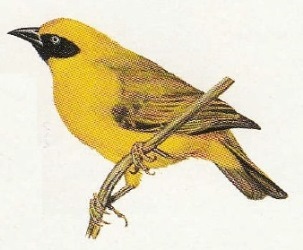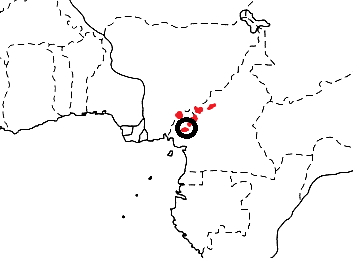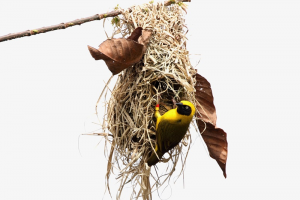Weaver species list / RELATED SPECIES: Baglafecht Weaver / Bannerman’s Weaver / Bertram’s Weaver / Giant Weaver / Orange Weaver / Principe Golden Weaver / Vieillot’s Black Weaver / Weyns’s Weaver
IUCN: Vulnerable Discovery: 111
Categories: IUCN
Discovery
 figure from Mackworth 1973a 
IntroductionBannerman’s Weaver was formally described by James Paul Chapin, an American ornithologist.Bannerman’s Weaver was collected in Cameroon by RH Drinkwater, who collected many birds in West Africa. Mr. Drinkwater obtained two adult specimens of this new weaver: one in the Nkongsamba district on 3 May 1930, and one in the Djang district on 7 May 1930. Chapin also found an older specimen that he recognised as the same species, and thus included in the type description. This specimen had been collected by Captain Boyd Alexander on 12 June 1909, at Ninong, Manenguba Mts., Cameroon. At the same site Alexander also collected two hybrid weavers and it was assumed that his Bannerman’s Weaver was a hybrdi rather than a new species. Chapin named this new weaver in honor of David Armitage Bannerman, a Scottish ornithologist, collector, and author. Bannerman had already published many papers on West African birds, and later wrote a handbook of 8 volumes on the birds of West Africa. The two Drinkwater specimens are in the American Museum of Natural History, while the Alexander specimen may be in the British Museum. Bannerman’s Weaver was first illustrated by Bannerman 1949a, being a line drawing of an adult. The next illustration of the species was a colour painting published in Mackworth 1973a. Scientific citationPloceus bannermani Chapin 1932a, Amer. Mus. Novit. no. 570 p.17, Djang district, Cameroon. Meaning of namesbannermani, Named after David Armitage Bannerman (1886-1979) Scottish ornithologist, collector, and author. First English nameBannerman’s Weaver (Bannerman 1949a). Alternate namesNone. CollectorRH Drinkwater; also Boyd Alexander. Date collectedMay 1930; also June 1909. Locality collectedDjang district, Cameroon (holotype). Type specimensThe types are in the American Museum of Natural History (AMNH 295349), and possibly in the British Museum. |
The above is based on Weaver Wednesday 2, a weekly series about the discovery of each weaver species.
This species text first appeared as Weaver Wednesday [228] – Discovery [111]: Bannerman’s Weaver on 2016-10-26
1. Basic biology
The above is based on Weaver Wednesday, a weekly series about weaver species.
This species text first appeared as Weaver Wednesday [81]: Bannerman’s Weaver on 2014-01-01
2. Breeding facts
| Pair bond Apparently monogamous Breeding season Nest site Nest building Colony size Clutch size Egg colour Egg size Incubation Chicks and nestling period |
Breeding information based on Handbook of the Birds of the World, Vol. 15.
3. Photos of Weaver Nests
 Vm 28364 |
 Vm 13804 |
 Vm 5068 |
Thumb-nails of most recent PHOWN records
